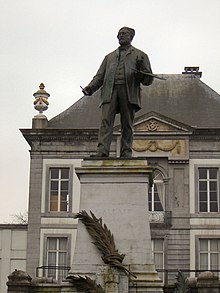Louis Gallait: Difference between revisions
Krenakarore (talk | contribs) info |
mNo edit summary |
||
| Line 11: | Line 11: | ||
"M. Gallait has all the gifts that may be acquired by work, taste, judgment and determination," wrote [[Théophile Gautier]]. His art is that of a man of tact, a skilled painter, happy in his dramatic treatment but superficial. No doubt, this [[Wallonia|Walloon]] artist, following the example of the Flemings of the Renaissance and the treatment of Belgian classical painters and the French Romantic school, sincerely aimed at truth. Unfortunately, misled by contemporary taste, he could not conceive of it excepting as dressed in sentimentality. As an artist employed by the State, he exercised considerable influence, and for a long period he was the leader of public taste in Brussels. |
"M. Gallait has all the gifts that may be acquired by work, taste, judgment and determination," wrote [[Théophile Gautier]]. His art is that of a man of tact, a skilled painter, happy in his dramatic treatment but superficial. No doubt, this [[Wallonia|Walloon]] artist, following the example of the Flemings of the Renaissance and the treatment of Belgian classical painters and the French Romantic school, sincerely aimed at truth. Unfortunately, misled by contemporary taste, he could not conceive of it excepting as dressed in sentimentality. As an artist employed by the State, he exercised considerable influence, and for a long period he was the leader of public taste in Brussels. |
||
==Bibliography== |
|||
* P. & V. Berko, "Dictionary of Belgian painters born between 1750 & 1875", Knokke 1981, p. 300. |
|||
==References== |
==References== |
||
Revision as of 17:21, 3 November 2012

Louis Gallait (9 or 10 May 1810 – 20 November 1887) was a Belgian painter. His d his reputation especially with the large painting of Charles V's abdication. Gallait's works were considered as the basis for a desirable renewal of historical paintings because of the realism, costume faithfulness and colorful posture of his paintings. His last artwork was sent on tour in Germany and that led to new signals even among German historians. He was also a distinguished portrait painter.
Gallait died in Brussels in 1887. There is a painting by Louis Gallait at the Norton Art Museum in West Palm Beach, Florida ("Art and Liberty").
Biography

Gallait was born in Tournai, Hainaut, Belgium in 1810. He first studied in his native town under Philippe Auguste Hennequin. In 1832 his first picture, Tribute to Caesar, won a prize at the exhibition at Ghent. He then went to Antwerp to continue his studies under Mathieu Ignace van Brée, and in the following year exhibited at the Brussels Salon Christ Healing the Blind. This picture was purchased by subscription and placed in the Tournai Cathedral. Gallait next went to Paris, and he sent to the Belgian Salons Job on the Dunghill, Montaigne Visiting Tasso in Prison, and — to the Brussels Gallery in 1841 — The Abdication of Charles V. This was hailed as a triumph and gained him a European reputation. Official invitations induced him to settle at Brussels.
Among his greater works may be named The Last Honors paid to Counts Egmont and Horn by the Corporations of the Town of Brussels, now at Tournai; The Death of Egmont, in the Berlin gallery; the Coronation of Baudouin, Emperor of Constantinople, painted for Versailles; The Temptation of St Anthony, in the palace at Brussels; The Siege of Antioch, Art and Liberty, Portrait of M. B. Dumortier and The Plague at Tournay, all in the Brussels gallery. A Gipsy Woman and her Children was painted in 1852. He also served as the director and president of the Académie Royale des Beaux-Arts.
"M. Gallait has all the gifts that may be acquired by work, taste, judgment and determination," wrote Théophile Gautier. His art is that of a man of tact, a skilled painter, happy in his dramatic treatment but superficial. No doubt, this Walloon artist, following the example of the Flemings of the Renaissance and the treatment of Belgian classical painters and the French Romantic school, sincerely aimed at truth. Unfortunately, misled by contemporary taste, he could not conceive of it excepting as dressed in sentimentality. As an artist employed by the State, he exercised considerable influence, and for a long period he was the leader of public taste in Brussels.
Bibliography
- P. & V. Berko, "Dictionary of Belgian painters born between 1750 & 1875", Knokke 1981, p. 300.
References
- This article incorporates text from a publication now in the public domain: Chisholm, Hugh, ed. (1911). Encyclopædia Britannica (11th ed.). Cambridge University Press.
{{cite encyclopedia}}: Missing or empty|title=(help)
External links
 Media related to Louis Gallait at Wikimedia Commons
Media related to Louis Gallait at Wikimedia Commons
